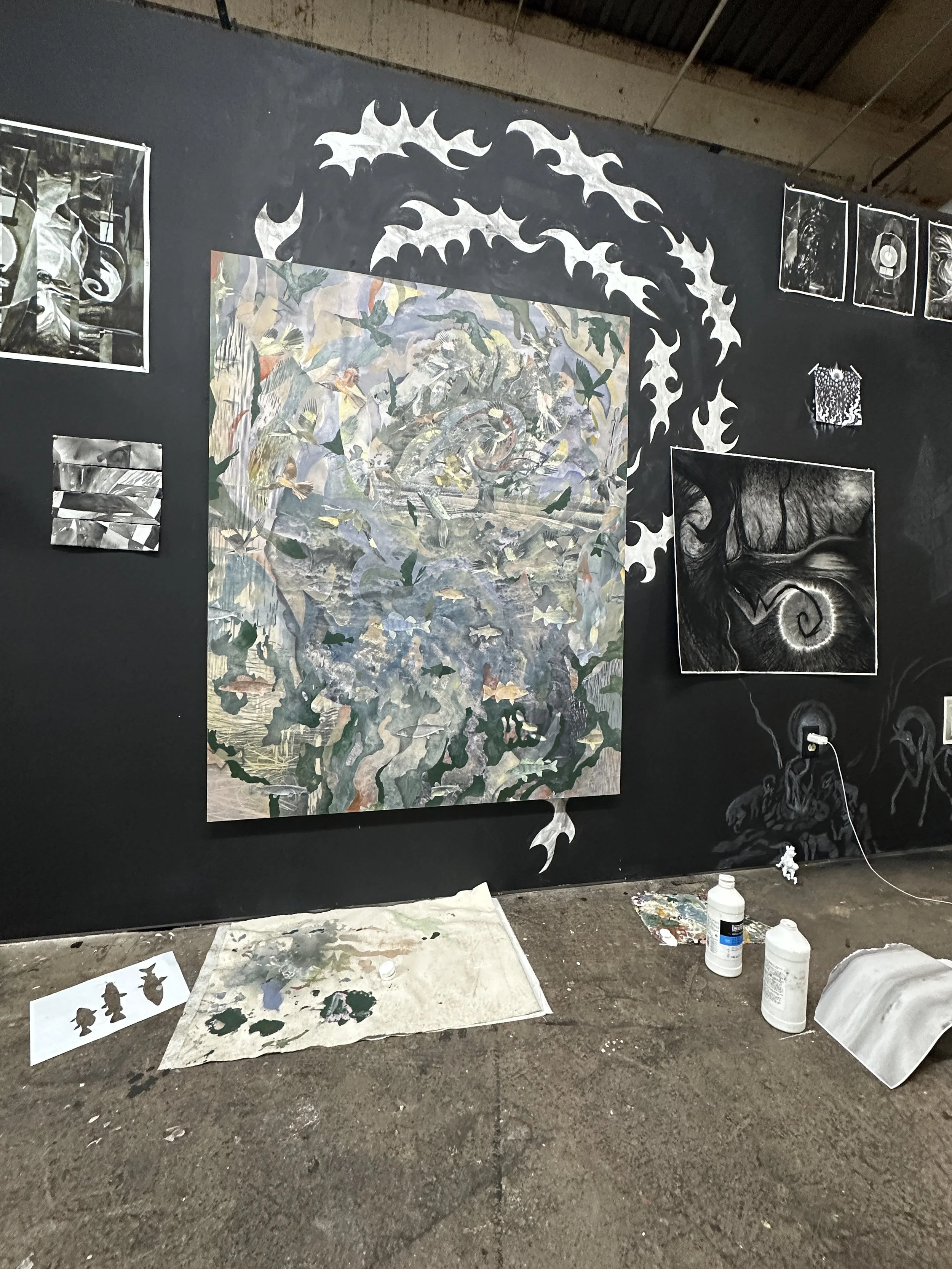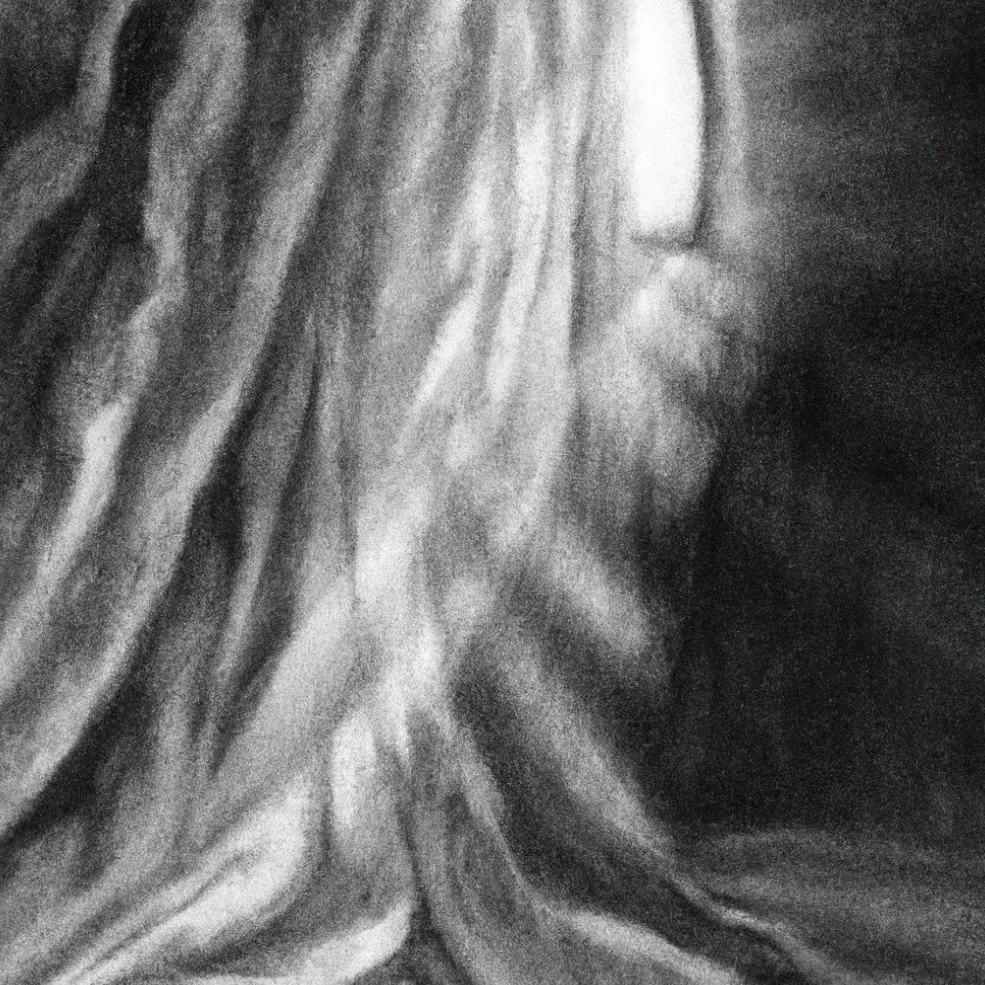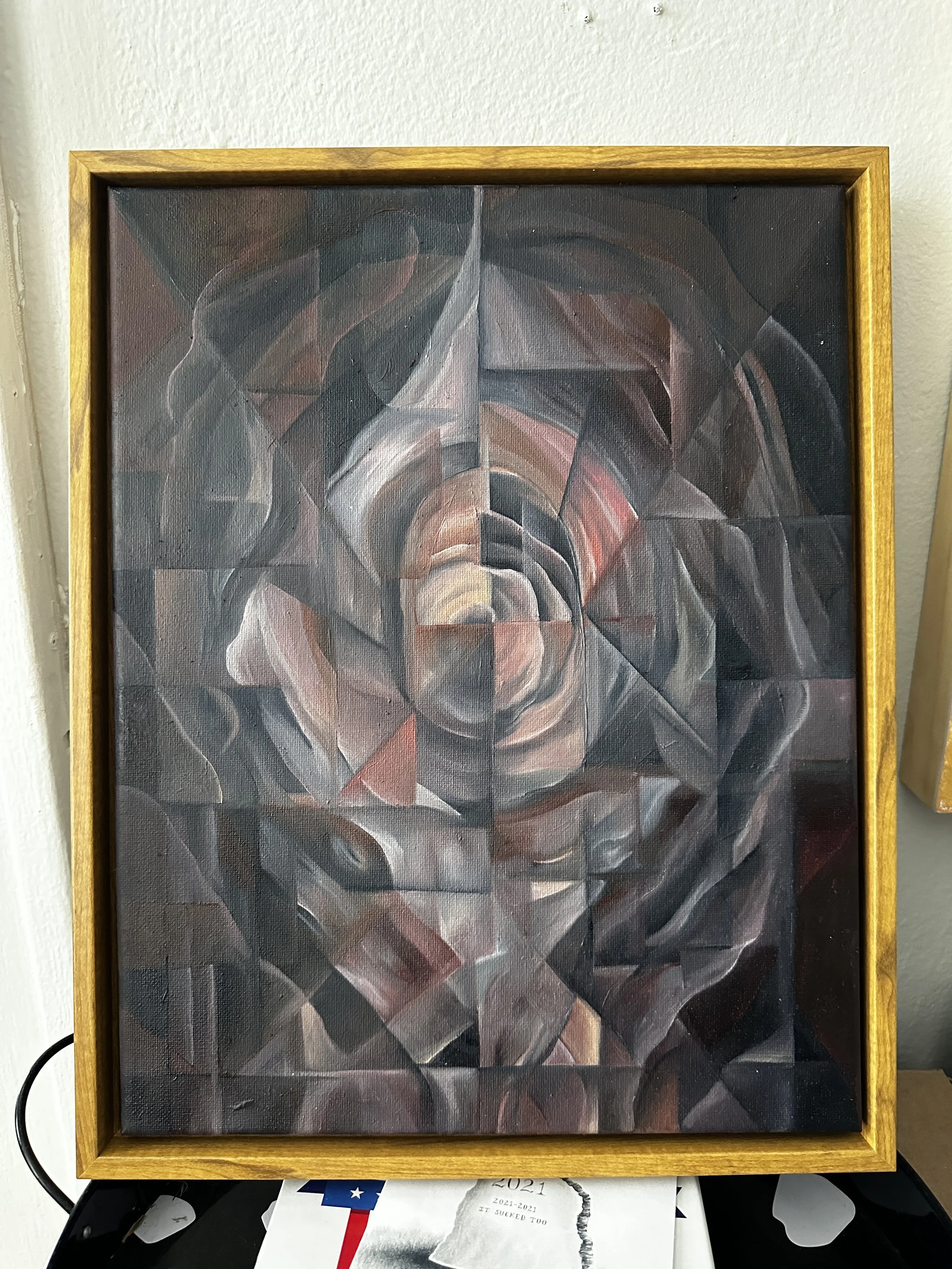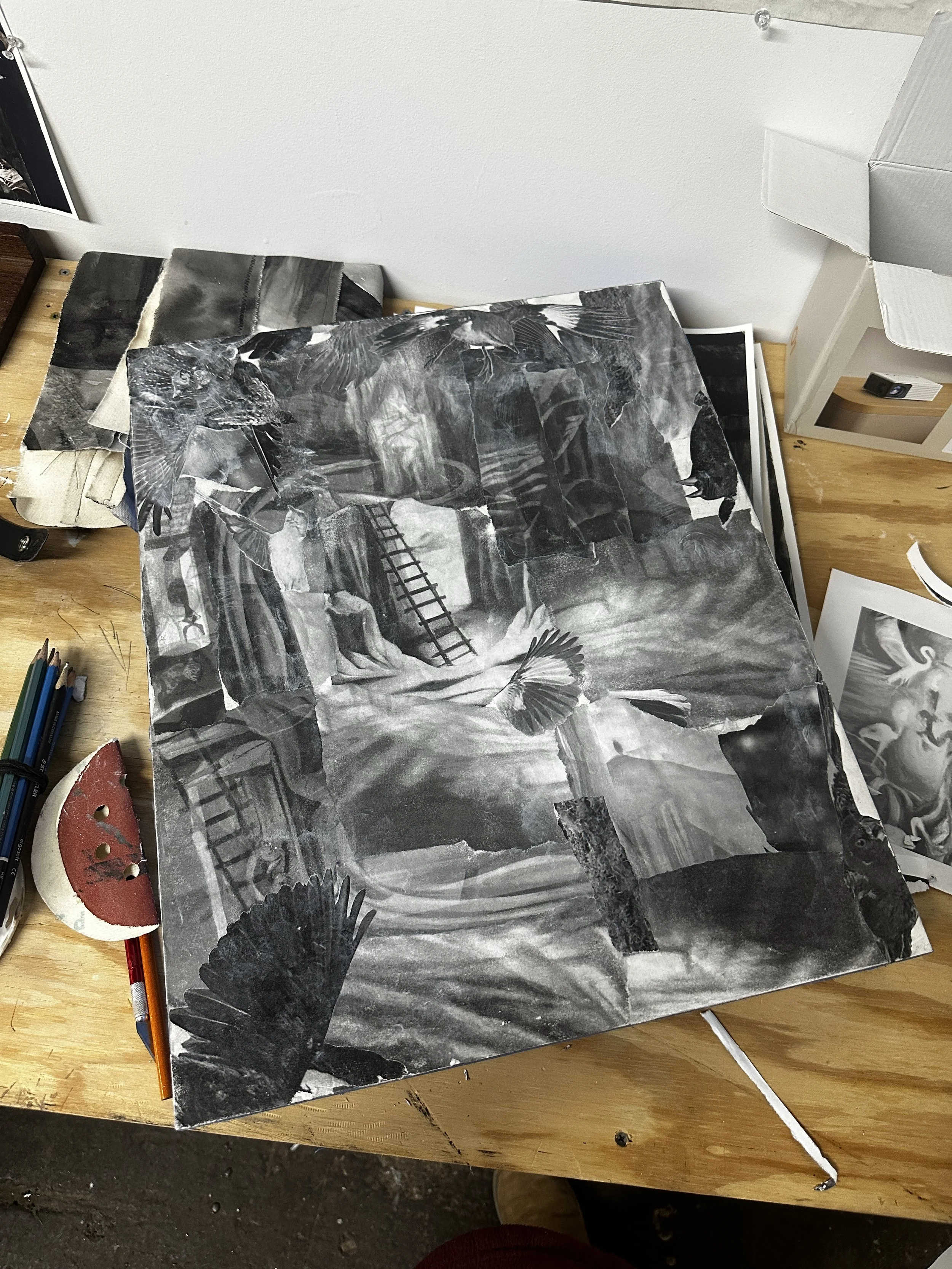For the last year, I’ve been a part of the Brewhouse Distillery residency. The program is aimed at emerging artists living in Pittsburgh. Moving here, doing Brewhouse was a goal because it would expand my network and give me access to space, but I didn’t know how powerful the year would be for myself and my work. The residency culminates in an exhibition, this year titled On the Edge Of. As both the residency and exhibition wrap up, I wanted to document and share all that’s been “brewing.”
I divided the year up into two phases. First, “research and development,” when I made and looked a lot, but didn’t force anything to be cohesive. Most of the work in the first half was black-and-white paintings or painting hybrids. I was obsessing over William Blake, watching a lot of surrealist ballet, doing some sewing, and listening to books about sleep (plug for The Nocturnal Brain by Dr. Guy Leschziner, it was great). I wrapped up this phase in December and spent that month sifting through all of the material, heading into my second phase, when I would make a cohesive body of work for the residency exhibition. Looking at my writings from that time, I had a pretty clear idea of what that work might be, until…
On New Year’s Eve, I was commissioned to do a large piece in a style I hadn’t touched since before grad school—essentially collaging onto panel and painting and drawing on top. Though I loved the technique, the imagery didn’t hold the kind of emotional (spiritual?) weight that I desperately wanted to see in my work after stumbling into Hilma af Klint’s Guggenheim retrospective in 2019. But in making the commission, I was really invigorated and wondered, What would it look like if I made work using this technique but with the imagery I’d built up over the last five years?
During “research and development,” I’d begun making digital collage-drawings and printing them out with the intention of using them as reference for physical drawings. I had tons of these printed behind my desk and as soon as I finished the commission, I began ripping and arranging them. A few days later, when you have a ladder but you want to be a bird was hanging in my studio.
In this work, I saw so much of what I’d been been trying to “distill,” not only for the last six months but for the last 12 years. First, the obvious, there was color. Though I love color (and have even taught entire color theory courses), I’ve never had a great relationship with it in my own work. Somehow, I’d always end up with a rainbow. I wanted to be Turner and would end up Lisa Frank. I spent the year after grad school trying to remedy this issue through oil painting. Most of these works ended up in the trash, but a few landed with friends in Denver and I still think of them fondly. The color in wyhalbywtbab connected to those pieces, but also to when I first moved to Colorado in 2016. My day-to-day drives past Garden of the Gods connected me to the planet in a way I’d never felt before. Quickly, seeking that connection became a huge part of how I set up my life. The warm earth tones of the Southwest are simultaneously grounding forces and sources of wonder and they felt well employed in the work.
Beyond color, spatially, the work reminded me of a theatre sets. As a high school thespian, I always imagined myself on stage, but now, I think the thing I loved most was the magic of late nights rehearsing: waiting in the wings for your cue, friends high on a scaffolding adjusting the lights, the darkness. There’s conspiratorial magic during rehearsal. In wyhalbywtbab, I saw the top portion as a stage, with the darker lower portion as the orchestra.
Sets suggest expansive worlds through the layering of flat imagery. To me, the same sense of space happens in dreams (or what I call my “night life”). In a dream, everything happens in the narrow space behind your eyelids. In my own dreams, I don’t usually see vast distances, but I’m aware of their existence around me. I rarely apply atmospheric perspective techniques to my drawings. Instead, through layering fairly low-depth landscapes, everything feels like it’s right at the front of the page. This work is about the things that happen right in front of you—be it in dreams, in theatres, or in your “real” life.
(Aside: That vertical sense of space also comes from Pittsburgh. Driving across the Birmingham Bridge to my studio, I’m always struck by the way the houses feel like they could tumble off the side of Mt. Washington. Their stacking feels so impossible.)
I populate my scenes with the imagery that haunts me in sleep: of climbing, falling, drowning, and being lost. All of the images are woven together, making it impossible to find an entrance or exit point. In wyhalbywtbab, the birds aren’t flying—they’re grounded and trapped behind transparent barriers. Being a bird sounds wonderful, but their fates are inextricably tied to the world they inhabit. There’s a lack of agency that exists in the work that also exists in being in an audience. In both cases, you don’t have control over what happens or where the narrative takes you. It plays out and you have to make sense of it.
I seek that same feeling of surprise and drama in making. If I knew exactly what a work was going to be, I wouldn’t need to make it. There’s a lot of fully formed pieces in my mind that I don’t need to make because I know what they are. The works that I have to make are the ones that are a mystery to me, who promise a thrill. Like in any good show, I’m on the hook for the ending. With so many steps in the process, there are a lot of places to get lost or lose the plot. I’m constantly improvising the maps these worlds require. The “yes-and” nature means that the process often dominates the result, but unlike a lot of process-based work, I am invested in some level of visual resolve. As an artist that “makes then thinks” (versus thinks then makes/executes), I have to accept a lot of “failed” work as a part of my method.
It would be very natural to say that I’m discovering what the work will be when I make it, but “discovering” suggests something new is being found. It is more like uncovering something latent—but to uncover is to literally remove and I am actively building up. What I’ve landed on, for now, is that the images have to be lifted out of my mind and onto the panel, giving the ideas room to move and be considered.
Like in a dream, I also feel like an audience member when I’m in deep in the making. The work plays out how it demands to play out and I am along for the ride. That said, I don’t want to be its only audience member and sharing the process is something I’m trying to be okay with. People really seem to want to understand how these works are made. I’m happy to share, but I also think there’s something to the mystery of these pieces that I wish could be preserved. It’s like figuring out how a magic trick is done, does it lose its luster in the knowing? That said, I can’t make work about flying and be cagey. Ultimately, I’ve found I feel happiest sharing with people one-on-one, when I can experience their “ah ha” moment with them.
I’ve joked that my ideal audience is the queer impresario of the Ballet Russe, Serge Diaghilev. Dead just under a century, I wonder if he’d see my work and commission me for a set. I wonder how Stravinsky would score the worlds I’d build and how Nijinsky’s dancers would move through them. The drama and absurdity of the Ballet Russe, whose imagery is of huge inspiration to me, directly reflected the world between wars that it inhabited, the disillusionment they felt, and their attempts to find wonder through it all. In the midst of what’s happening in Palestine and here in the US, it’s hard not to relate.
For myself, I have to admit to a fairly high level of disillusionment. When I started this work, it was as a means of reconciling my sleep paralysis, my recurring nightmares, and the PTSD of a home invasion (which occurred while I was in bed) with the fact that I have to sleep in spite. But the content kept expanding, encompassing the questions that are ever-present in my day life—Should I move back into my car? Should I live in the city? Or move back to the mountains? Can I have everything at once? Am I lonely or alone? Will I always feel this lost? Then even further beyond me, to the big wide world. What happens when all of these untenable infrastructures and grids and systems finally fail? What does that look like? How does that feel? After the climax, there’s the denouement. Most of this work exists then. These places aren’t empty by any means, but their lack of humanity has both questions and implications.
I can see all of this—the most personal and the most pertinent—in this work.
I always tell students not to try to put every idea they have into every single work, but I’m so guilty of trying to do just that. At the opening of On the Edge Of, a local friend and painter said, “It’s rare that you see all of the little bits in someone’s studio come together in the final work.” I knew he meant it as a compliment, but I don’t know if he knows that it’s the compliment.
I’ve been at this art-making in earnest since 2014. I’ve made a lot of work I like, I’ve made a lot of work I know to be “good,” but I haven’t made work that feels so mine it’s like looking in a mirror. I keep wanting to return and look at it, like a baby seeing themselves for the first time (lol, but genuinely). Beyond that, when I talk/write about the work, I believe myself and feel deep ownership of the ideas. It’s not that I’ve never believed in my work, but writing artist statements has always been a chore—a necessity. I definitely wasn’t sitting down on a Thursday morning in the summer and laying out my thoughts because it felt good to do so (and definitely wasn’t desperately trying to recreate them exactly at the pub that night, after accidentally deleting them).
I’m excited about this work and I’m even more excited to keep making it. I see how drawings will re-enter to deepen the world-building. I find myself wanting to share my writing, my sketchbooks, all the little bits, and let people connect things. When I first made when you have a ladder but you want to be a bird, I left a friend a voice message on my drive home saying, “I want to do this for a long time,” and I do.
Invasion of the Day is the last and largest work I made for this show. It takes place in the first light of morning, when the day can be anything. I’m moving forward in that sense of possibility, believing I really am “on the edge of…”







